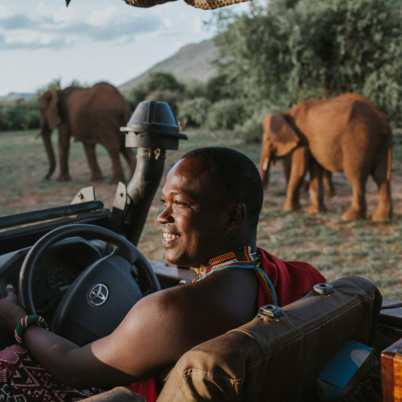Our luxury safaris to Amboseli National Park
Discover Amboseli safaris your way with customized safari itineraries tailored to your interests and preferences.
-
Explore This Trip
Kenya Classic Flying Safari
Amboseli National Park, Masai Mara, Diani Beach
11 NightsFrom £8,660 PPThis 11-night itinerary captures the essence of a Kenyan safari. Starting in the luxury hotel of... -
Explore This Trip
Africa: The Ultimate Safari Tour
The Ngorongoro Crater, Serengeti National Park, Giraffe Manor, Victoria Falls, Okavango Delta, and Cape Town
28 NightsFrom £26,900 PPThis Unforgettable trip includes a variety of exciting safari experiences across East and Southern... -
Explore This Trip
Kenya Explored
Ol Pejeta Conservancy, Samburu National Reserve, Masai Mara
10 NightsFrom £7,900 PPThis itinerary is a combination of driving and flying, combining both the popular parks with the...
Ready to plan your trip?
What ever you want from your dream trip, our team of
experts are ready to help.
Our luxury Amboseli safaris

Gemma
Africa Specialist
As well as reliable elephant sightings, Amboseli National Park also has good numbers of lion prides, and plains game such as zebra, giraffe, and a wealth of antelope species. You will enjoy morning and late afternoon safaris, often in open-sided vehicles with professional safari guides. This park is particularly good for photographers – both amateur and professional – because many of the safari camps have specialized vehicles for photographers and their equipment, as well as experienced guides who know the best angles and lighting for the perfect shot.
The safari experience in Amboseli National Park is also more varied, as you can do activities like bush walks, cycling, community visits, and day and night drives. On top of that, you will enjoy some safari surprises along the way, such as breakfasts in the bush, and sundowners in front of waterholes, filled with resident hippo pods or crocodiles. It’s a very special park, and the safari camps in this area really have perfected the safari experience for guests. We recommend Amboseli National Park as either a stand-alone safari destination, or to combine it with another park like the Masai Mara National Reserve, and small aircraft planes make it possible to do this.






When to visit Amboseli National Park
The best time to visit Amboseli National Park is the June to October window, which is the dry season in Kenya. This period also offers warm weather and plenty of sunshine. In turn, this makes for great visibility, for both game viewing and also the opportunity to see the incredible Mount Kilimanjaro in Tanzania. The period of December to March is also a good time to visit, with dry and warm weather also offered. The rainy season between April and May makes game viewing less reliable because of the thicker vegetation and cooler temperatures. That said, it can make for a dramatic backdrop, especially for photographers.
Request our brochure
Explore the world with us – request our worldwide brochure today and embark on a journey of unparalleled destinations and unforgettable safaris.
Our Signature Brochure
Advice from the travel experts

Kenya or Tanzania – which destination is best for me?
While the African continent offers some incredible safari experiences, East Africa offers a very wild and authentic safari. The national parks and reserves and unfenced which means that animals can roam as much as they want, migrating for hundreds of...Read More
15 reasons to go on a safari in Kenya
Located in East Africa, Kenya is one of the most popular safari destinations across the continent. It’s home to the famous Masai Mara National Reserve, the Great Migration, and bordered by a coastline of the glistening Indian Ocean. The game...Read More
Your Amboseli safari questions answered
What safari activities can I do in Amboseli National Park?
Typical early morning and late afternoon game drives are offered in Amboseli National Park. The animals – particularly the big cats – are at their most active in the early hours of the morning, before the sun rises and the temperature starts to rise. This is why game drives start around 6am so that you have the best opportunity to see them. This is also the same reason as to why the afternoon game drives start around 3-4pm. The middle of the day is usually the hottest and the animals are at their least active, so game drives during this time are unproductive. Along with game drives, the safari camps in Amboseli National Park also offer bush walks, community visits, cycling, and walking experiences.
How long should I spend in Amboseli National Park?
We’d recommend a minimum of three nights on safari in Amboseli National Park. It’s possible to drive to the park from Nairobi, which we can arrange in a private 4×4 safari vehicle with a private driver/guide. This is approximately a 4-hour drive, but there are also airstrips in Amboseli which offer a much more direct route into the park. If you are combing Amboseli National Park with other safari destinations, such as the Masai Mara National Reserve, I’d recommend a split of 3 nights in each. This gives you a good amount of time to enjoy the game viewing activities on offer.
What is Amboseli famous for?
Amboseli National Park is made up of a variety of landscapes including vast, open savannahs, dry and arid plains, and more bushy swamps. These diverse landscapes are home to a range of animals – from huge elephant herds to coalitions of cheetahs. While the park is not home to the Big Five (there are no rhino here), the park has an exceptional reputation for elephant numbers, big cat sightings, and birdlife. The park is also regarded as the best destination for views across Africa’s largest mountain – Mount Kilimanjaro.
Where should I stay in Amboseli National Reserve?
There are a handful of safari camps we recommend in Amboseli National Park. Some luxury safari camps are part of a larger portfolio of camps in Kenya, which helps with combining destinations. For example, Tortilis Camp is part of the Elewana Collection, which has sister camps all across Kenya – the Masai Mara National Reserve, the Greater Mara Conservancies, the Laikipia Plateau, and the Kenyan coast to name a few. Combining sister camps and properties can be great value, so do let us know if you are looking to combine multiple destinations and we can curate a luxury trip for you.
You may also like
Why book with Unforgettable Travel Co.
-
100% Financial Protection
We are a licensed and fully bonded tour operator financially protected by both the Civil Aviation Authority (ATOL) and the Association of Bonded Travel Organisers Trust (ABTOT). All clients that travel with us are fully financially protected.
-
Destination Experts
Our travel experts live and breathe the destinations they specialise in. This shows in their passionate to create hand crafted trips for our clients. We don’t offer cookie cutter trips, just truly unforgettable journeys unlike any other.
-
The Best Guides
What makes our trips extraordinary is the unique immersive experiences we include. We pride ourselves in our black book of sought after expert guides, game rangers and local contacts who believe in our philosophy, unforgettable.
-
We Care
From the moment you book your trip, we are on hand 24/7 to assist you throughout your journey. With regional offices around the world, we have ground logistics teams on hand to help you every step of the way.
Ready to plan your trip?
What ever you want from your dream trip, our team of
experts are ready to help.
COPYRIGHT © 2024 UNFORGETTABLE TRAVEL. ALL RIGHTS RESERVED










